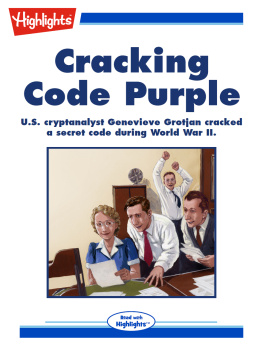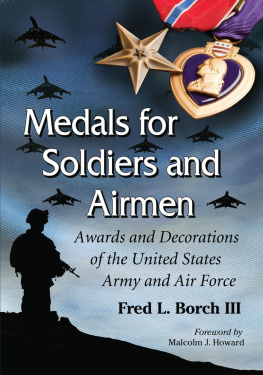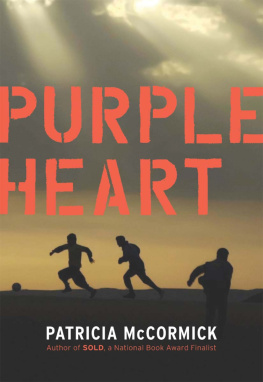For Military Merit
RECIPIENTS OF THE PURPLE HEART
Fred L. Borch
NAVAL INSTITUTE PRESS
Annapolis, Maryland
The latest edition of this work has been brought to publication with the generous assistance of Marguerite and Gerry Lenfest.
Naval Institute Press
291 Wood Road
Annapolis, MD 21402
2010 by Fred L. Borch
All rights reserved. No part of this book may be reproduced or utilized in any form or by any means, electronic or mechanical, including photocopying and recording, or by any information storage and retrieval system, without permission in writing from the publisher.
ISBN 978-1-61251-409-3 (eBook)
The Library of Congress has cataloged the hardcover edition as follows:
Borch, Frederic L., 1954-
For military merit / Fred Borch.
p. cm.
Includes bibliographical references and index.
1. Purple Heart. 2. United StatesArmed ForcesBiography. 3. United StatesArmed ForcesRegisters. I. Title.
UB433.B664 2010
355.1342dc22
2010009804
 Print editions meet the requirements of ANSI/NISO z39.48-1992 (Permanence of Paper).
Print editions meet the requirements of ANSI/NISO z39.48-1992 (Permanence of Paper).
14 13 12 11 10 9 8 7 6 5 4 3 2
First printing
Contents
Sgt. David L. Brainard
Sgt. Brainards Purple Heart (reverse)
Col. William D. Alexander Purple Heart certificate
Pvt. Joseph Sinks Purple Heart (obverse & reverse)
MSgt. Llewellyn Chilson
Maj. Gen. Robert T. Frederick
Col. Russell P. Reeder
Capt. Charles A. Wirt
Col. Russell M. Blair
Brig. Gen. Rhonda L. Cornum
Seaman William Sneaths Purple Heart (reverse)
Lt. John McCloy
Fon B. Huffman
Lt. B. Wooster, Lt. R. Mason, Lt. (j.g.) A. Reynolds
Cdr. Robert J. Flynn
Cdr. Lloyd M. Bucher
Lt. Mark L. Donald
Gen. George C. Kenney
Col. Fred V. Cherry
Col. Philip J. Conran
Col. George E. Day
Maj. Pollard H. Mercers Purple Heart (reverse)
MSgt. Timothy A. Wilkinson
Senior Airman Diane Lopes
Maj. Gen. Wilburt S. Brown
Brig. Gen. Robert L. Denig, Sr.
Cpl. R. Guy Robinson
Sgt. John Basilone
Maj. Gen. James L. Day
Cpl. Emil Elias
SSgt. Timerlate Kirvin & Cpl. Samuel J. Love, Sr.
2nd Lt. John T. Chamberlains Purple Heart (reverse)
Col. Wesley L. Fox
LCpl. Joseph B. Perez
Seaman 1st Cl Donald J. Andersons Purple Heart (reverse)
Seaman 3rd Class Douglas A. Munro
Mr. Ernest T. Pyle
The Sullivan brothers
Gen. Mark W. and Maj. William D. Clark
Gen. George S. Patton Jr.
Lt. Gen. Lewis B. Chesty Puller
Sgt. David and Spc. Nancy Romero
Sgt. James K. Arness
Pvt. James Garner
Brig. Gen. William J. Wild Bill Donovan
Lt. John F. Kennedy
Gen. Colin L. Powell
Col. David H. Hackworth
Gen. Douglas MacArthur
Maj. Gen. Charles E. Chuck Yeager
I t is an honor to have the opportunity to participate in this work, the first devoted entirely to Purple Heart recipients. It is important; the Purple Heart means a lot to the people who wear them and to the people who award them.
In 1990 I was assigned as the flight surgeon for the 2nd Battalion, 229th Aviation Attack Helicopter Regiment, and deployed to Saudi Arabia as part of Operation Desert Storm. Six months later, on February 27, 1991, we were flying a search and rescue mission for a downed F-16 pilot. Our UH-60 Black Hawk helicopter was flying very low and very fast. Unfortunately, we were not successful in rescuing the pilot, and our Black Hawk was shot down by Iraqi ground fire. Five of the eight soldiers on the helicopter were killed. I was very lucky to survive the crash with a gunshot resulting in a fractured right shoulder and a left humeral fracture from the crash. These wounds made it clear to me what direct result of enemy action means to a soldier.
The Iraqis held me as a prisoner of war until the end of hostilities. After being released from captivity on March 5, 1991, and returning to the United States for medical treatment, I received a number of medals and decorations. These included a Distinguished Flying Cross, a Bronze Star Medal, and a Purple Heart.
Years later, from July 2003 to July 2005, I had the privilege to command Landstuhl Regional Medical Center, the major stop in the evacuation chain from Europe, Africa, and Southwest Asia. I saw thousands of men and women who had been awarded Purple Hearts for wounds received in action in Afghanistan and Iraq, and I was privileged to personally award some to patients in our intensive care unit.
The point is that I know something about the Purple Heartand those who receive it. Consequently, I am really pleased to write a few words as the Foreword for this book.
As For Military Merit: Recipients of the Purple Heart makes clear, the Purple Heart is not an award for suffering. It is not an award for hardships endured, or pain experienced during battle. On the contrary, as retired Army colonel Fred Borch, the author of this book, explains in the first chapter, the Purple Heart was intended by Gen. Douglas MacArthur to inspire the living by recognizing soldiers who had been wounded as a direct result of enemy action. But while MacArthur believed that those who had been wounded in combat had performed meritorious service, he never intended for every war injury to recognized with a Purple Heart. Rather, only wounds that were serious enough to require treatment by a medical officer were eligible. These are still the requirements today. This explains why the Purple Heart is specifically not awarded for post-traumatic stress disorder, frostbite, or heat stroke, for example. While these conditions frequently develop during combat operations and may be devastating, they are indirect results of combat and depend on the psychological and physiological makeup of the individual soldier, sailor, Marine, airman or Coast Guardsman.
More than a million Purple Hearts have been awarded to military personnel since 1932, and the medal continues to be viewed by Americansboth in and out of uniformas proof that a soldier was wounded during honorable combat with the enemy.











 Print editions meet the requirements of ANSI/NISO z39.48-1992 (Permanence of Paper).
Print editions meet the requirements of ANSI/NISO z39.48-1992 (Permanence of Paper).